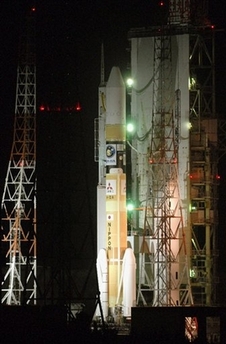Japan launches moon probe
Updated: 2007-09-14 10:37
Tokyo -- Japan's space agency launched its much-delayed lunar probe Friday, beginning what it calls the largest mission to the moon since the US Apollo flights.
 An H2-A rocket is prepared at space center in Tanegashima, southern Japan Thursday night, Sept. 13, 2007. [AP] |
The Selenological and Engineering Explorer - or SELENE - probe was launched aboard one of the space program's mainstay H-2A rockets from its launch-pad on remote Tanegashima island.
Footage of the launch carried live over the Internet showed the rocket racing upward through slightly hazy skies to the southeast. Japan Aerospace Exploration Agency said the craft's engines and navigation systems appeared to be operating normally.
The launch of the $279 million SELENE probe came four years behind the agency's original schedule. Japan launched a moon probe in 1990, but that was a flyby mission, unlike SELENE, which is intended to orbit the moon.
It canceled another moon shot, LUNAR-A, that was to have been launched in 2004 but had been repeatedly postponed because of mechanical and fiscal problems.
A mid-August launch date for the SELENE also had to be scrubbed after some improperly installed components were discovered that required replacement.
The SELENE project is the largest lunar mission since the US Apollo program in terms of overall scope and ambition, outpacing the former Soviet Union's Luna program and NASA's Clementine and Lunar Prospector projects, according to Japan's space agency.
It involves placing the main satellite in orbit at an altitude of about 60 miles and deploying the two smaller satellites in polar orbits. Researchers will use data gathered by the probes to study the moon's origin and evolution.
The main orbiter will remain in position for about a year.
|
|
|
||
|
||
|
|
|
|